Introduction
The ASUS MyPal A600 computer based on the Pocket PC is the first offering from
this manufacturer. The ASUS's experience in production of mobile equipment lets
us hope that its first product won't be spoiled, as it often happens in small
companies. A share of this company on the world market makes me think that the
production volumes of the MyPal will be quite large and the delivery will be regular.
As you know, ASUS is known for high-quality products offered at moderate prices
- I believe the policy regarding the PDA will be the same, and the A600 will sport
an advantageous price/quality ratio.
Appearance
Let's pop into the box with the new PDA. Inside we find the computer itself,
a cradle of a funny shape, a charger, a cover of thick fabric covered inside with
soft nap, a relatively small user manual and a CD with software. The Deluxe version
comes with an additional CD with programs and utilities meant for the PDA. Well,
the accessory pack is standard for a mid-level assistant.
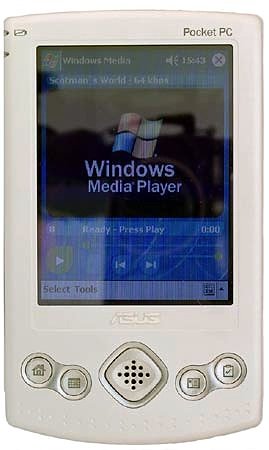
The design of the MyPal A600 is ordinary at the front - this is a usual
case made of aluminum alloy of an unsophisticated shape; however, it's
not deprived of elegancy which will please those who like a strict business
style. The application shortcut buttons are recessed into the case, first
they are not easy to press, but then, after a click, they easily go into
the case; their are equal in diameter to the finger-pad - all these things
prevent from occasional pressing when the device is in your pocket. The
joy-stick is small and tight, - on the one hand, it won't loose or produce
sounds for the speaker located behind it, but on the other hand, it's easier
to work with a bigger joystick - as that installed in the iPAQ.

Being 12.8 mm thick, the MyPal A600 is one of the slimmest Pocket PCs
for today. This gadget is thus an excellent stylish accessory for a businessman.
From the ergonomic standpoint such solution has both supporters and opponents.
I think that it's quite convenient to hold this PDA, and the fact that
it's very comfortable to wear makes up for minor drawbacks. But such a
thin case with smooth side panels must be carefully held as it can easily
slip out of your hands. Its even and smooth edges, in contrast to the Fujitsu
Siemens Pocket LOOX, won't let us forget that we are dealing with an expensive
egg-shell.

The left panel sports a semi-JogDial (it has a limited degree of rotation),
a record button and a power button. When you hold the PDA in your left
hand, your thumb falls onto the record button with a probability of 80%.
But it also can get onto the power switch. The buttons do not jut out of
the case's surface, but they are very soft, and occasional pressing is
not excluded. The upper panel traditionally offers a headphones jack, a
mic-in, IrDA and a SecureDigital slot with a protective door.
A plastic solid stylus of an average size has a circular section, which
makes easier to put it into its nest; the stylus is handy enough, though
it might seem to be too light for some users. A touch screen, like in most
Pocket PCs, is soft and pleasant to press on.
A pleasant blue backlight of the application shortcut keys goes on when these
keys are pressed. That pleases much, especially when you are working in the dark.
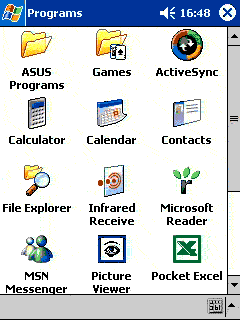
|
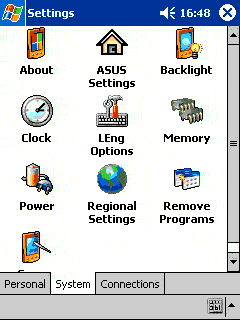
|
| Programs menu is typical of the Pocket PC 2002, except the "Asus
Programs" item |
Beside from standard parameters there are "Asus Settings" |
The cradle is not the best. Having an effective look, the device doesn't
allow putting the PDA in the connector at one stroke. The back of the cradle
is flexibly connected to the base, and the PDA moves towards the connector
at a certain angle to its axis, - the connector thus sets against the slot
and you have to move the PDA forth and back to establish the connection.
Peculiarities
A screen of the MyPal A600 is a standard for a Pocket PC 3.5" reflective
TFT matrix of 320x240 pixels with a backlight whose source is located along the
lower edge. Brightness doesn't fluctuate sharply along the screen, but it smoothly
decreases to the upper edge, - it's unnoticeable in most applications but well
seen when reading e-books. Saturation and contrast of the matrix are typical of
the Pocket PC, only the iPAQ 39xx can boast of better quality. The screen's backlight
can be adjusted gradually - there are 255 steps. At the maximum, the PDA turns
into a flash-light.
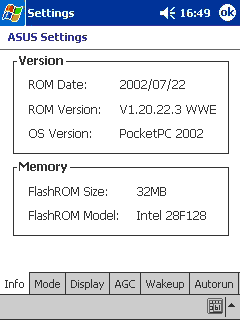
|
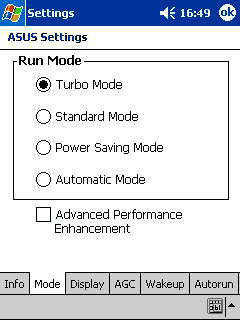
|
| System information |
Processor modes |
Off-line operation
The PDA's battery from ASUS is Li-Pol, 1200 mAh. It's hidden under the solid
back panel and you can't take if off. Well, if you are going to use it intensively,
the computer must be charged up every day, and it's impossible to replace the
battery with a new one.
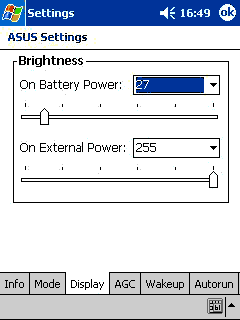
|
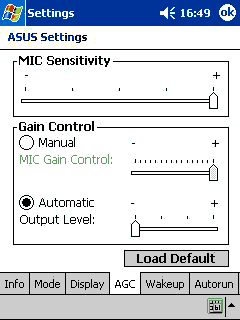
|
| Screen Brightness adjustment |
Microphone sensitivity adjustment |
As you know, the Xscale processors have reduced power consumption, which must
alleviate power supply problems. To check that we fulfilled several tests. But
before I turn to them let me draw your attention to a utility that allows manual
switching between power consumption modes of the CPU (i.e. clock speed). The Power
Management mode is set to automatic by default, but you can choose standard, power
saving or turbo modes. Their impact on performance will be discussed later, and
now let's estimate the time of running from a full battery. The first test was
a continuous playback of MP3 files with a built-in Windows Media Player in headphones,
backlight off (it switched on from time to time for a short operation with the
PDA), maximum volume level. In the power saving mode the player stopped working
in 11.5 hours. In the turbo mode the duration was 5 hours. At the peak load we
played a small video clip in the PocketDivX 0.8. The processor was set to the
turbo mode. The device could endure that one hour, and after that we could send
and receive data vie IrDA and synchronized information through the cradle during
40 minutes. This approximately amounts to 1 h 20 m - 1 h 30 m of playing video,
i.e. this handheld does not yield to its rivals in this aspect. On the whole,
the ASUS MyPal A600 has the edge on the run-down time as far as many other Pocket
PCs are concerned, though this strong point becomes weaker because of the unremovable
battery construction.
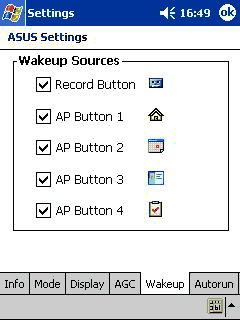
|
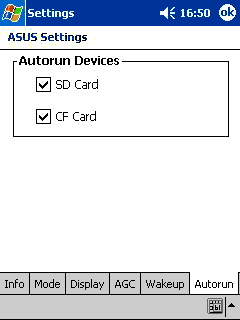
|
| PDA wake-up mode adjustment |
Adjustment of response to a memory card |
The weakest point of the MyPal A600 is that it determines battery's charge
incorrectly. It's probably caused by errors in the algorithms of calculation of
time of operation of the PXA250 processor in the specific modes. The most problems
show up in the turbo mode - when we played video in the turbo mode we got the
first warning that the battery needed to be charged yet at the 10the minute (though
it was charged up by 70%), after that the gadget worked 40 minutes more, then
several more warning messages followed at the interval of 1 minute and then the
computer switched off. In other conditions it was the same: in the turbo mode
the first warning came onto the screen when the battery was still full, then it
appeared again when the battery level was 30-35%. In the other modes the system
isn't so persistent, but there is another trouble, - the battery's level is determined
incorrectly. After a long charging process (several hours, - the system must have
shown 100%) it indicated just 90%, the indication might remain unchanged for a
long time and then go down rapidly and freeze at another level (in this case a
user will be annoyed with persistent warning messages). If we switch to the less
power consuming mode the battery level will go up, which, though, looks logical
as this parameter actually shows how much time (percentage wise) from the maximum
is left.
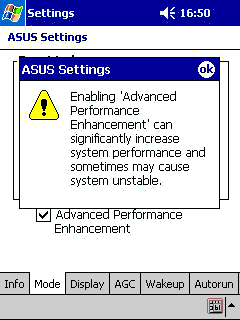
|
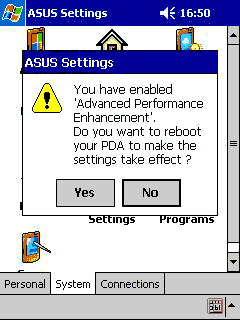
|
| "Advanced Performance Enhancement" mode enabled |
PDA asks for rebooting |
Standard software bundle
The ASUS MyPal A600 incorporates just the Pocket PC 2002 platform without any
additional programs. It misses shell modifiers and program launchers which are
often installed by other manufacturers (and quite often they are unremovable).
I think it's the best solution as the original interface of the Pocket PC isn't
less interesting than any other, and experienced users can always organize it
to their liking by adding new features and programs.
There is the only add-on - ASUS Settings located in the Settings
menu in the System tab. We have already mentioned its most interesting
function - forced switching of processor modes. Besides, it can provide
information on a type and size of flash memory and firmware version, adjust
screen contrast (separately for power supply from battery and from mains),
adjust MIC sensitivity, set hot keys to wake up the PDA and control auto
start-up of applications from memory cards. Well, the utility doesn't set
the world on fire, but it pleasantly supplements capabilities of the Pocket
PC with new features.
Speed of operation
Performance of the new model is what we are mostly interesting in as this is
the first thorough test of a production sample of the Pocket PC 2002 based on
the Intel PXA250. Efficiency of such computers running under the current OS in
applications not compiled for a given CPU doesn't differ from a typical one. We
are going to test it, especially because we can change the processor's speed and
compare performance in different modes.
In my opinion, in the standard, power saving and off-line modes the
MyPal A600 works at a usual rate, though in the power saving one the interface
has a lot of delays, and when lengthy files are processed the delays become
considerable. In the power saving mode video in the DivX format plays jerkily,
in the standard mode some frames drop out and dynamic scenes are too pixilated.
But in the turbo mode all programs flies, the interface responds without
any delays, the movie is played in the PocketDivX smoothly and with high
quality.
Below are the scores obtained with the VOBenchmark program:
| VOBenchmark |
NEC P300E |
Asus MyPal A600 |
| |
(reference) |
Power Saving Mode |
Standard Mode |
Turbo Mode |
Automatic Mode (batt. pwr) |
| CPU FP |
8.04 |
3.17 |
6.32 |
12.67 |
6.32 |
| CPU Int |
15.84 |
6.18 |
13.53 |
27.02 |
13.5 |
| Graphics/Bitmap/BitBlt |
11.94 |
10.59 |
18.02 |
34.1 |
17.96 |
| Graphics/Bitmap/StretchBlt |
0.55 |
0.3 |
0.5 |
0.95 |
0.5 |
| Graphics/Filled/Ellipse |
1.02 |
0.47 |
0.7 |
1.11 |
0.72 |
| Graphics/Filled/Rectangle |
1.36 |
0.56 |
0.86 |
1.41 |
0.88 |
| Graphics/Filled/RoundedRect |
0.8 |
0.43 |
0.53 |
1.00 |
0.52 |
| Memory/Allocation |
8.83 |
3.3 |
6.59 |
13.22 |
6.6 |
| Memory/Fill |
0.53 |
0.45 |
0.46 |
0.94 |
0.46 |
| Memory/Move |
0.84 |
0.19 |
0.2 |
0.37 |
0.2 |
| Text |
2.89 |
0.94 |
1.35 |
3.43 |
1.77 |
First of all, let's see how different processor modes affect the overall
performance. As you can see, the standard mode is almost twice better than
the power saving one in all tests. And the turbo mode is twice speedier
than the standard one.
The tests also shed light on operation of the automatic power consumption
management. It turned out that when the charger is connected the processor
is turned into the power saving mode. It's interesting that notebooks which
support automatic CPU frequency management are turned into the most efficient
mode in case of external power supply. But the ASUS's solution has a logical
explanation: the processor consumes less energy so that the battery can
be charged up as fast as possible. Besides, in none of the tests the PDA's
performance gets higher than in the standard power consumption mode. Well,
the test has no really tough tasks and the algorithms keeps the CPU in
the standard mode. Unfortunately, the VOBenchmark suite doesn't measure
PDA's performance when MP3 or DivX are played and we couldn't check whether
the processor works to its full capacity when fulfilling these tasks.
Now I'm going to compare might of the ASUS MyPal A600 with that of the
StrongARM 206 MHz based NEC Mobile Pro 300E which is equipped with the
same stuff. In the turbo mode which entirely enables capabilities of the
CPU XScale the MyPal A600 performs always better than its rival, and in
most cases it outpaces the latter by a great margin (by 25-30% - in this
case a user can notice the difference without making special measurements).
But in the standard mode, which is used most of all, the MyPal A600 is
almost always slower than the Mobile Pro 300E. It seems that it's caused
by the software which is optimized for the StrongARM, though the flaws
in the ASUS's solution can also take place. I think the gap is not critical
because it causes no discomfort in typical applications (looking through
an address book, reading books, simple games, MP3 playback), and for tough
programs the A600 has its ace - the turbo mode.
Summary
What this amounts to is a handheld of a nice look, handy and bugless (except
problems with warning messages on charging). Its run-down time is rather lengthy,
though it still keeps you tied to the mains, and although it doesn't break records
in performance, it is able to speed up marginally. At $620 it's more expensive
than models bundled with 64 MB RAM and StrongARM 206 MHz processor from brand-name
PDA makers, but at the same time it comes with the latest CPU PXA250. ASUS didn't
shift down the price bar for middle-level PDAs, but it enhanced the appearance
and add more clever features to such computers. Well, it's a rational solution
from the marketing standpoint. Missing wireless interfaces (Bluetooth, Wi-Fi)
is not a disadvantage because they usually come with high-level PDAs, and here
you can use respective expansion cards.
The ASUS MyPal A600 answers the call from the mobile users who want
a mid-level PDA of the best price/capabilities ratio (the A600 is the cheapest
Xscale based computer and shows an excellent performance in the turbo mode),
do not escape from civilization achievements (it's necessary to charge
it up every 1-3 days, removable accumulators or batteries can't be used),
are going to handle it carefully (it's slim, the metallic casing is smooth
and the edges are even, the cradle needs attention), and like an appealing
but not extremal design (thin, elegantly shaped). I'm sure there are quite
a lot of such people out there...


